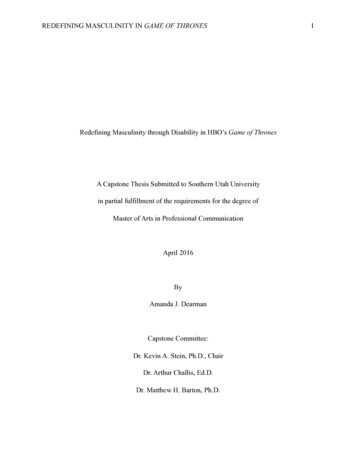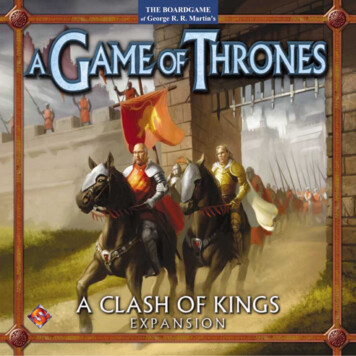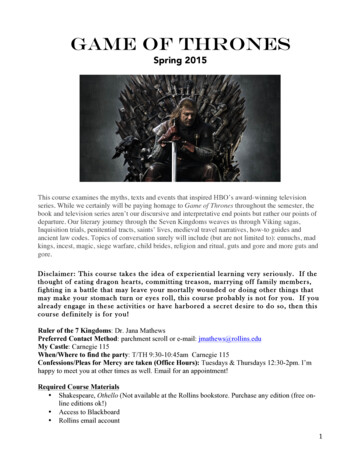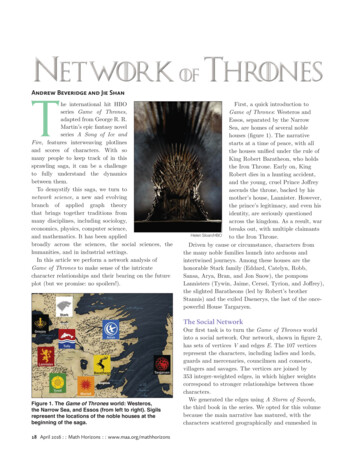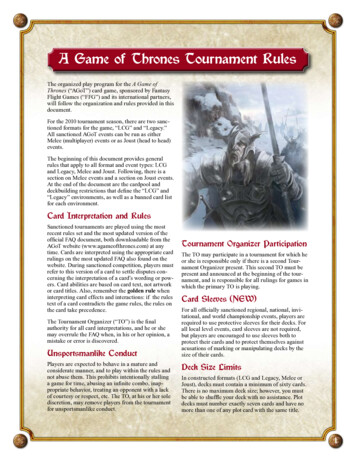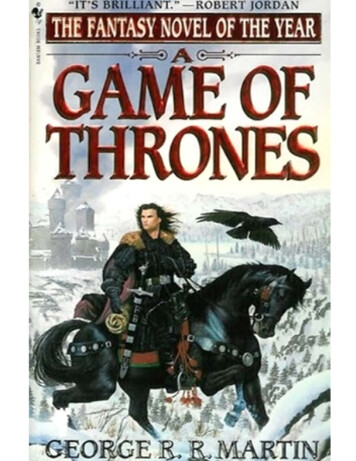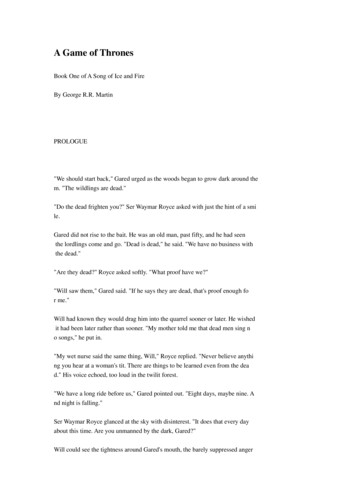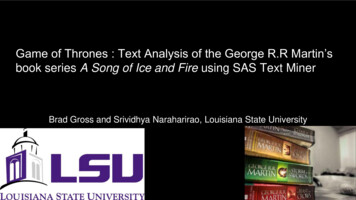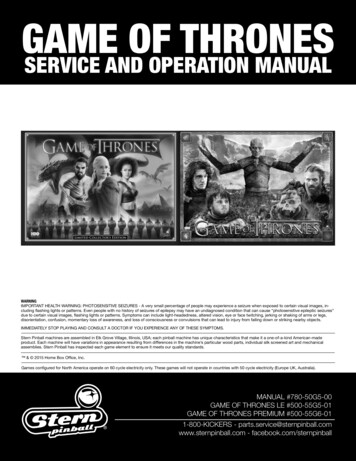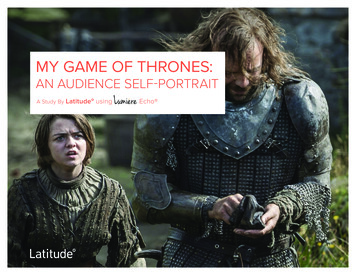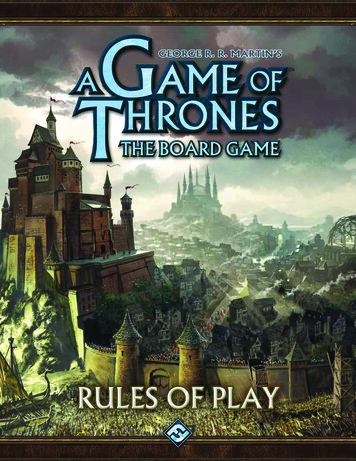
Transcription
A Game of ThronesC o m po n en t Li st“The Iron Throne is mine by rights. All those who deny that are myfoes.” - Stannis Baratheonɇɇ This Rulebookɇɇ 1 Game Boardɇɇ 138 Colored Plastic Units consisting of: 60 Footmen (10 per House) 30 Knights (5 per House) 36 Ships (6 per House) 12 Siege Engines (2 per House)ɇɇ 81 Large Cards consisting of: 42 House Cards (7 per House) 30 Westeros Cards 9 Wildling Cardsɇɇ 24 Small Tides of Battle Cardsɇɇ 2 Reference Sheetsɇɇ 6 House-specific Player Screensɇɇ 266 Cardboard Tokens consisting of: 90 Order Tokens (15 per House) 120 Power Tokens (20 per House) 18 Influence Tokens (3 per House) 6 Supply Tokens (1 per House) 14 Neutral Force Tokens 6 Victory Point Tokens (1 per House) 6 Garrison Tokens (1 per House) 1 Iron Throne Token 1 Valyrian Steel Blade Token 1 Messenger Raven Token 1 Game Round Marker 1 Wildling Threat Token 1 King’s Court Overlay“The whole of the realm denies it, brother. Old men deny it with theirdeath rattle, and unborn children deny it in their mothers’ wombs. Theydeny it in Dorne and they deny it on the Wall. No one wants you fortheir king. You may well have the better claim, but I have the largerarmy.” - Renly Baratheon“When you play the game of thrones, you win or you die.”- Cersei LannisterOverviewA Game of Thrones: The Board Game is a game for three to sixplayers, based on George R. R. Martin’s bestselling A Song of Iceand Fire novels. In A Game of Thrones: The Board Game, playerseach control one of six Great Houses seeking dominance over thelands of Westeros. By mustering armies, conquering territory andforming alliances, each House strives to control the most Castlesand Strongholds so it may ultimately claim the Iron Throne.Ob ject of the Ga m eAt the end of the 10th game round, the House that controls themost areas containing either a Castle or Stronghold is declared thewinner. If, at any time during the game, a player controls seven suchareas, that player immediately wins the game.Number of PlayersA Game of Thrones: The Board Game supports three to sixplayers. If playing with three, four, or five players, first read thisentire rule book and then follow the instructions under “Playingwith Fewer Than Six Players” on page 28 .2
A Game of ThronesNeutral Force TokensCo mpone nt Ove rvi ewRepresent the forces of independentareas unwilling to submit to player controlwithout resistance.The following list briefly describes the components found inA Game of Thrones: The Board Game.Game BoardGarrison TokensDisplays the continent of Westeros andseveral important game tracks.Represent the inherent defensive strengthof each player’s home area.Player ScreensDominance TokensUsed by players as a reference guideand to hide available Order tokens fromopponents.Awarded to the dominant player on eachof the three Influence tracks on the gameboard: the Iron Throne, the Fiefdoms, andthe King’s Court. These tokens provide theirowners with special abilities used at variouspoints in the game.Plastic UnitsFootmen, Knights, Ships, and Siege Engineunits, representing the military might ofeach House.Game Round MarkerTracks how many game rounds have been played.Order TokensHouse CardsImportant commands issued by players tounits in areas on the game board.Represent important characters fromA Song of Ice and Fire called uponduring combat.Power TokensRepresent political and economic influencein Westeros. These are used in bidding and toestablish control of game board areas.Westeros CardsRepresent random events and game proceduresthat occur at the start of each game round.Influence TokensTides of Battle CardsUsed to indicate the position of each House onthe three Influence tracks.Optional game module that enhances the risksand uncertainty of combat.Supply TokensWildling Cards and Threat TokenUsed on the Supply track to indicate themaximum size and quantity of armies each playercan field on the game board.Tracks the strength and effects of attacksagainst Westeros by the northern wildlings.Victory Point TokensThe King’s Court OverlayPlaced on the Victory track to indicate howclose each House is to winning the game.Balances the availability of Special Order tokens in three andfour players games.Reference SheetsProvide helpful reference informationabout card and token effects in A Game ofThrones: The Board Game.3
A Game of ThronesG AME SET U P5. Place Game Round Marker: Place the Game Roundmarker on the “1” position of the Round track.Before playing the game, perform the following steps in order:1. Prepare the Game Board: Unfold the game board andplace it in the center of the play area.6. Determine Player Houses: Each player now selects whichHouse he wishes to control during the game (Stark, Lannister,Greyjoy, Tyrell, Baratheon, or Martell). Alternatively, playersmay randomly determine which House each player will control.When playing a game with fewer than six players, some Housesare not eligible to be played, see page 28.2. Prepare the Wildling Deck and Wildling ThreatToken: Shuffle the Wildling cards to form a deck. Place this deckon the space provided at the top of the game board. Then place theWildling Threat token on the “2” position of the Wildlings track.3. Prepare the Westeros Decks: Separate the Westeroscards into decks according to their roman numeral (I, II, or III).Shuffle each deck and place them separately facedown next tothe game board.7. Gather House Materials: Each player gathers allmaterials belonging to his House. These are: 1 player screen,7 House cards, 15 Order tokens, 1 Supply token, 3 Influencetokens, 1 Victory Point token, 1 Garrison token, and allplastic units of his color (do not take any House-specificPower tokens yet).4. Place the Neutral Force Tokens: First collect theNeutral Force tokens marked with the correct range ofplayers. Then place those tokens on the areas of the gameboard matching the name on each token.8. Place Influence, Victory and Supply Tokens: Each playerplaces his Victory, Supply, and Influence tokens on the gameboard tracks as instructed by his player screen. Unlike theInfluence tracks, more than one House may share the sameposition on the Victory and Supply tracks.For example, in a three-player game, place only Neutral Forcetokens marked with the “3” icon. Used with four orfive playersIf playing with fewer than six players, slide every Influencetoken to the left (towards the “1” position) on each Influencetrack to fill any leftward empty position (in other words, thehighest numbered positions on each track remains emptyand unused in games with fewer than six players). The SetupDiagram on page 5 illustrates how Influence tokens have beenshifted left in a four-player game.Used only withthree playersAll Neutral Force tokens are double-sided. One side is usedexclusively when playing with three players. The reverse side isused if the current number of players fall within the indicatedplayer range. After placing all necessary Neutral Force tokens,return any unused tokens to the box.The Houses occupying each “1” (i.e., left-most) position on eachInfluence track now claim the pictured Dominance token forthat track (the Iron Throne, the Valyrian Steel Blade, or theMessenger Raven token).9. Place Units: Each player then places all of his startingunits on the game board according to the instructions on hisplayer screen.When playing with four, five, or six players, not every NeutralForce token is used. See “Playing With Fewer Than 6 players” onpage 28 for a complete list of which tokens to place.10. Place Garrison Tokens: Each player places his Garrisontoken on his home area (matching the area name on the token).11. Gather Power Tokens: Place all Power tokens (forall Houses) in a central pile. This pile of Power tokens isreferred to as the “Power Pool.” Each player then takes fivePower tokens matching his House from the Power Pool.Exceeding theComponents ProvidedEach House is provided a limited number of units,tokens, and cards. If a player is using all his components ofa particular type, he may not bring additional componentsof that type into play. Units that are destroyed in combat (orremoved from the board for any other reason) are available tobe mustered again.The game is now ready to begin!4
A Game of ThronesSetup Diagram(four-player 13.14.15.16.17.18.19.20.Game BoardWildlings TrackWildling DeckWesteros Deck IWesteros Deck IIWesteros Deck IIIA Neutral Force TokenA Garrison TokenRound TrackVictory TrackSupply Track5Influence TracksPlayer ScreensHouse Cards (Player Hand)House Cards (Discard Pile)Order TokensAvailable Power TokensPower PoolDominance TokensKing’s Court Overlay (3-4 players only)
A Game of ThronesThe Player ScreenImportant Terms!1Be sure to read and understand the following termsbefore continuing:Unit: A plastic Ship, Footman, Knight, or SiegeEngine. Other component types (including Garrisons,Neutral Forces, or Influence tokens) are not units.43Area: A region of Westeros as depicted on the gameboard and divided by white or red borders. An area is eithera sea area (red borders) or a land area (white borders).2Each player takes the player screen that represents hisHouse. The player screen provides reference information, setupinformation, and enables players to sort and store components(such as Order tokens) privately during the game.1.Order token reference2.Starting units information3.Starting position on Supply, Influence, and Victory tracks4.House unit setup map (illustrating the starting unitsinformation)Home Area: A land area containing the printed shieldof its House. For example, Winterfell is the home area ofHouse Stark.Turn Order: Any game mechanic that operates in“turn order” is resolved in the order of House position onthe Iron Throne Influence track. The first House (in the “1”position) always acts first, followed by the second House(in the “2” position), etc.House/Player: Interchangeably used in these ruleswhen referring to a player and/or the House he controls.Enemy/Opponent: Describes any game component orarea controlled by another player, or describes the rivalplayer himself.The Houses of WesterosFriend/Friendly: Game components or game boardareas belonging to the same player.During the time of A Song of Ice and Fire in which A Gameof Thrones: The Board Game is set, the following Houses are theprincipal players in the struggle for the Iron Throne.Army/Armies: An army is defined as two or morefriendly units sharing the same sea or land area. A singleunit occupying an area is not considered an army (and istherefore unaffected by changes in supply, see page 8).House Stark “Winter is Coming”A reclusive family with honorable traditions that has beenreluctantly pulled into the game of thrones.Available Power: Power tokens in a player’s play area,available to be bid or otherwise spent during gameplay.Power tokens in the Power Pool are not considered availablepower. For example, during game setup, each House receivesfive Power tokens from the Power Pool. In this way, each Househas five available power at the beginning of the game.House Greyjoy “We Do Not Sow”Nurturing wounds from its failed rebellion, this bitter clanhas bided its time to once more launch its longships upon thewestern coasts of Westeros.House Lannister “Hear Me Roar”Collect/Receive/Discard Power: When instructedto receive or collect power, a player takes the indicatednumber of Power tokens bearing his House insigniafrom the communal Power Pool. When instructed to“discard” power, the player takes the Power tokens fromhis available power and returns them to the Power Pool.A player may only collect, receive, or discard Power tokensbearing the insignia of his own House.An ambitious family whose rich gold mines and relentlesscunning has made them a formidable and dangerouspower in the realm.House Martell “Unbowed, Unbent, Unbroken“Fierce and unforgiving, this ancient family has thrived andgrown powerful under the scorching sun of Dorne.House Tyrell “Growing Strong”Destroy: A unit that is destroyed during the game isremoved from the game board and returned to a player’savailable units in his play area.Even as their fertile lands are considered the heart ofchivalry in Westeros, this proud family has never satupon the Iron Throne; a fact it hopes to soon correct.Embattled Area: The area in which a combat currentlyHouse Baratheon “Ours is the Fury”is taking place.The troubled but strong-willed family of Robert Baratheon,the late King, holds the strongest claim of succession to theIron Throne.6
A Game of ThronesT he Ga m e R o u n dA Game of Thrones: The Board Game is played over 10 game rounds,each consisting of the following three phases:The Westeros Cards1. The Westeros Phase (skipped game round 1)The top card of each Westeros deck is drawn, after whicheach card is resolved in order (I, II, then III). Westeros cardsrepresent important game procedures and events.There are three decks of Westeros cards, each markedwith a roman numeral. When revealing and later resolvingWesteros cards during the Westeros Phase, always start withdeck I, followed by deck II, and then deck III.2. The Planning PhaseEach player simultaneously assigns facedown Order tokens toeach area containing one or more of his units.1. Event Title and Artwork2. Deck Number: The number in the right-hand boxindicates which Westeros deck this card belongs to (alsoindicated on the card back).3. The Action PhaseThe Order tokens assigned during the Planning Phase are nowresolved. The majority of player activity in A Game of Thrones:The Board Game takes place during this phase.3. Text Effect: Describes how this card affects gameplay.After each Action Phase, a new game round begins, startingwith another Westeros Phase.4. Wildling Icon: Some cards show a Wildling icon in theupper right corner. During the Advance Wildlings Track step,the Wildling Threat token is advanced one space for each ofthese icons present on the drawn Westeros cards.If at any time during the game a player controls seven areascontaining a Castle or Stronghold, the game is over and thatplayer is the winner. Otherwise, the game lasts until the end ofthe 10th game round, at which point the player who controls themost areas containing a Castle or Stronghold wins the game (see“Winning the Game” on page 16).4T he Westeros PhaseDuring this phase, players draw and resolve three Westeroscards, one from each Westeros deck.Note: Skip this phase during the first game round, proceedinstead directly to the Planning Phase.1The Westeros Phase consists of the following steps:1. Advance Game Round Marker: Advance the GameRound marker one position on the Game Round track.3If the Game Round marker was on the 10th space at the start ofthe Westeros Phase, it’s not possible to advance the Game Roundmarker. Instead, the game is over and a winner is determined(see “Winning the Game” on page 16).24. Resolve Westeros Cards: Now, in order of decknumber (starting with numeral I), resolve each revealedWesteros Card.2. Draw Westeros Cards: Reveal the top card of all threeWesteros decks.3. Advance Wildlings Track: Countthe number of Wildling icons on thethree revealed Westeros cards (if any) andmove the Wildling Threat token forwardWildling Iconthat many spaces on the Wildlings track.If, during this step, the Wildling Threattoken reaches position “12”, a Wildling Attack is immediatelyresolved (ignore any surplus Wildling icons). Read how toresolve wildling attacks on page 22.To resolve a Westeros card, simply read the card’s text andimplement its effects. Many cards are self-explanatory, butsome require a detailed understanding of their specifiedeffect. The resolution effects of those important Westeroscards are found on the following pages.7
A Game of ThronesWesteros Card: SupplySupply ExampleLannister has recently lost control of Riverrun andSeagard to Greyjoy (each of which contains a single Supplyicon). During a later Westeros Phase, a “Supply” card isrevealed. Due to the loss of these areas, Lannister must nowadjust his actual Supply from 5 to 3.Before the “Supply” card is drawn, Lannister has four armiesof 4, 3, 2, and 2 units.Armies require enormous amounts of supplies to functionefficiently: food, water, steel, horses, clothing, etc. Without adequateprovisions, an army will quickly deteriorate.When resolving the “Supply” Westeros card,each House, in turn order, counts the numberof Supply icons printed in areas it controls, andthen moves its Supply token on the Supply trackto reflect that level of supply.Lannister also controls several areas containing a singleunit, but as single units do not form an army, supply limitshave no effect on them.As Lannister’s supply drops to 3, he can no longeradequately supply some of its armies. As indicated on theSupply track, a supply of 3 allows Lannister to field fourarmies with the sizes: 3, 2, 2, and 2. To reconcile with his newsupply level, Lannister destroys one of his Footmen at TheTwins and one of his Footmen at Harrenhal.Supply IconEach column on the Supply track has a resulting set of flags.These flags illustrate the number of different armies, and themaximum number of units in each such army, that a House mayfield on the game board.For example, a House with a supply of “3” may field four armies: onearmy with a maximum of three units, and three smaller armies eachwith a maximum of two units.Reminder: An army is defined as two or more friendly units inthe same land or sea area. A single unit is not considered an army,and has no supply consideration.In the illustration above, Stark (with actual supply of two) is ableto field up to three armies, being two armies each containing twounits, and one army containing up to three units. Both Lannister andBaratheon have more supply, and therefore can field proportionallymore (and larger) armies.After a player adjusts supply, he must ensure the actual number(and size) of his armies on the game board do not exceed hissupply limits. If his armies do exceed new supply limits, he mustimmediately remove units from the game board until his armynumber (and size) conforms to that allowed by his position on theSupply track.ɇɇ Though a player may gain or lose Supply icons on the gameboard throughout one or more Action Phases, his armiesare reconciled only when the Supply track is adjusted (via a“Supply” Westeros card, or other game effects).Other Supply Rulesɇɇ A player is never allowed to take any action in the gameɇɇ A player is allowed to have fewer and/or smaller armiesthat would cause him to exceed his actual supply limitas dictated by his position on the Supply track (such asmustering, marching or retreating, all explained later).than the limit provided by his position on the Supply track.ɇɇ Though a Knight or a Siege Engine unit are stronger thanFootmen or Ship units, they only count as one unit for thepurpose of supply.8
A Game of ThronesWesteros Card: MusteringMustering Example3The “Mustering” Westeros card represents the efforts of thegreat Houses in calling their bannermen to action, in trainingand outfitting warriors, assembling warships, and constructingmassive engines of war.1When resolving the “Mustering” Westeros card, each player,in turn order, may recruit new units into each area he controlsthat contains a Castle or Stronghold. Each Castle or Strongholdprovides mustering points which may be spent to recruit newunits in its area:24A Mustering card is revealed during the Westeros Phase.Lannister (with Supply of 3) is first player in the turn order andnow musters new units.1. He uses one of the two mustering points provided inLannisport to place a Footman unit at Lannisport and the otherto place a Ship unit in the Golden Sound.Strongholds each provide 2points of mustering2. Turning his attention to Harrenhal, he uses its singlemustering point to upgrade one of his two Footmen units thereto a Knight (upgrading does not affect army size).Castles each provide 1 point ofmustering3. Since he already has an army of three Knights at Riverrun,he uses one of his mustering points at Riverrun to place anotherShip in the Golden Sound (which is adjacent to Riverrun),creating an army of two Ships. He cannot use the one remainingmustering point at Riverrun since he has met his Supply limit.The mustering cost of each unit type is as follows:4. Lannister also controls Stoney Sept, but since that areacontains neither a Castle or Stronghold, no mustering takesplace there.Footman: Costs 1 point of musteringKnight: Costs 2 points of mustering (or 1point if upgraded from a Footman)Each player must resolve all his mustering (for all areascontaining his Castles and Strongholds) before the next player inturn order can start his mustering.Ship: Costs 1 point of musteringSiege Engine: Costs 2 points of mustering (or1 point if upgraded from a Footman)Mustering Ship UnitsA mustered unit is taken from its player’s unused units, andplaced directly into the area of the Castle or Stronghold thatprovided the mustering point(s) to muster it.Ship units, like other units, are mustered by an area containinga Castle or Stronghold. Unlike other unit types, however, Ship unitsmay only be placed in a port connected to the mustering area or in anadjacent sea area (see page 25 for more detail on ports).A Footman unit located in a mustering area (i.e., an areacontaining a Castle or Stronghold) may be upgraded to (i.e., replacedwith) a Knight or Siege Engine unit for a cost of 1 mustering point.Ship units cannot be mustered into sea areas that contain oneor more enemy ships. If a Castle or Stronghold area has no port oreligible adjacent sea areas, no Ship units can be mustered there.A player may never muster a unit that would create orexpand an army beyond his actual supply limit. In other words,if mustering a new unit would cause a player to have more (orlarger) armies than allowed by his position on the Supply track,that unit cannot be mustered.Remember that two or more Ship units in the same seaarea are considered an army, and must conform to a House’ssupply restrictions like any other army. (While it would be moreaccurate to call multiple Ship units a fleet, the term army is usedfor simplicity.)If an area containing a Castle or Stronghold is unable to musteror upgrade a unit (or its owner decides not to muster or upgrade inthis area) its mustering points are lost (i.e., they do not contribute toa future mustering here).Unlike Ship units, Footmen, Knight, and Siege Engine units maynever be mustered in ports or sea areas.9
A Game of ThronesWesteros Card: Clash of KingsBidding on the Influence TracksWhen bidding on each Influence track, players first hide alltheir available power tokens behind their player screens. Then eachplayer secretly places any number of his available power tokensinto his hand, hiding them in a closed fist. Once all players havemade their selections, everyone simultaneously reveals their bid byopening their hands.The player with the highest bid places one of his Influencetokens on the “1” position of the track being bid upon. The playerwith the second highest bid places one of his Influence token onthe “2” position of the same track, the third highest player on the“3” position, etc.From the invasion of the First Men to the reign of the Andalkings; from the fiery conquest of the Targaryens to the rebellion ofRobert Baratheon, the continent of Westeros has known constantmilitary upheaval. Yet, the game of thrones is not always playedon the battlefield. Intrigue, betrayal, and assassinations have felledmany a contender, and so has lack of support from the minor housesof Westeros. A House that dares set its eyes on the Iron Throne mustturn many wheels within wheels to achieve its ends.The outcome of all ties in bidding is decided by the playerholding the Iron Throne token. This player places the Influencetokens of tied players on the highest (i.e., left-most) availablepositions on the track, in the order of his choice.All power tokens bid by players, regardless of outcome, arediscarded to the Power Pool.The “Clash of Kings” Westeros card simulates the intrigue andplotting quietly taking place behind the curtain of war, affecting it inmany subtle (and some not-so-subtle) ways.After all Influence tokens have been placed on the trackundergoing bidding, the player occupying the track’s “1” positionis awarded its Dominance token (Iron Throne, Valyrian Steel Blade,or Messenger Raven token, see page 11 for more detail onDominance token abilities), then players proceed to bid on the nextInfluence track.To resolve “Clash of Kings,” first remove all Influence tokensfrom the three Influence tracks on the game board. Players thenbid available power for position on the three tracks. The biddingis resolved one track at a time, starting with the Iron Thronetrack, followed by the Fiefdoms track, and ending with the King’sCourt track.After bidding for the King’s Court track is completed and theMessenger Raven awarded, the Clash of Kings Westeros card hasbeen resolved and the game continues. All remaining Power tokensare returned to the front of each players’ screen.Influence Track Bidding ExampleDuring a five-player game, a “Clash of Kings” card has beendrawn in this round’s Westeros Phase. Players have alreadyfinished bidding on the Iron Throne track (with House Greyjoywinning the first place and the Iron Throne Dominance token).Lannister claims the first spot on the fiefdoms track, placing hisInfluence token on the “1” position.Baratheon and Stark are tied for the second-highest bid.Greyjoy (who currently controls the Iron Throne Dominance token)decides that Baratheon’s Influence token will be placed on the “2”position and Stark on the “3” position.Tyrell, being the fourth-highest bidder, places his influencetoken on the “4” position, while Greyjoy, who bid the least, placeshis token on the “5” position. The “6” position will remain unusedas this is a five-player game.Bidding now proceeds to the Fiefdoms track. Each playerhides his available power behind his player screen and secretlyplaces a number of Power tokens in his hand, making a closedfist. The bids are then revealed simultaneously, with thefollowing results:After all Influence tokens have been placed on the track, HouseLannister takes the Valyrian Steel Blade token as his reward forclaiming the first spot on the Fiefdoms track.ɇɇ Lannister: 4 Powerɇɇ Baratheon: 3 Powerɇɇ Stark: 3 Powerɇɇ Tyrell: 2 Powerɇɇ Greyjoy: 0 Power10
A Game of ThronesThe Influence Tracks and Dominance TokensThe game board features three different Influence tracks:The Iron Throne track, the Fiefdoms track, and the King’s Courttrack. The player in the highest position on each track receivesa specific Dominance token: The Iron Throne, the Valyrian SteelBlade, or the Messenger Raven. The effects of each Influencetrack and its respective Dominance token are described below.Whenever a player uses the Valyrian Steel Blade, he flips thetoken over to its faded side, indicating it has been used this gameround. At the end of every Action Phase (and thus the end of thatround), the holder of the Valyrian Steel Blade flips the token backto its fully colored side, indicating it is available to be used againin the next game round.The Iron Throne TrackThe King’s Court TrackThe order of Influence tokens on the Iron Throne Influencetrack determines the turn order. When resolving anything inturn order, always start with the player whose token is in the “1”position on the track, followed by the player whose token is in the“2” position, etc.A House’s position on the King’s Court track determines thenumber of Special Order tokens available to that House duringthe Planning Phase. The higher a House’s position (i.e., closer to“1”) on the King’s Court track, the greater the number of SpecialOrder tokens available to that House.The player whose token is in position “1” of the Iron ThroneInfluence track holds the Iron Throne token.The player whose token is in position “1” of the King’s CourtInfluence track holds the Messenger Raven token.The Iron Throne TokenThe player holding this token decidesthe outcome of all ties that occur inthe game, with the exception of ties incombat (which are resolved by a player’sposition on the Fiefdoms track) and ties indetermining the winner of the game.Note: The Iron Throne token does notThe Iron Thronechange hands until bidding for the IronTokenThrone track has been resolved and allInfluence tokens have been placed on that track. Thus, the playercontrolling the Iron Throne token still breaks ties when biddingon the Iron Throne track, even though he may lose the IronThrone token after the bidding is over.The Fiefdoms TrackThe player with a higher position (i.e., closer to “1”) on theFiefdoms track wins ties in combat against a player in a lowerposition (see “Combat” on page 17).The player whose token is in position “1” of the FiefdomsInfluence track holds the Valyrian Steel Blade token.Remember, all ties outside of combat and determiningthe winner of the game are decided by the holder of the IronThrone token, including ties in bidding for the Fiefdoms track.The Valyrian Steel Blade TokenThe Valyrian Steel BladeTokenThe number of special orders provided by the King’s Courttrack is indicated by the number of stars printed by eachposition on the track (some lower positions award no specialorders). More information on special orders can be found under“The Special Orders” on page 22.In three and four player games, the King’s Court overlaytoken is placed over the King’s Court track to alter the number ofspecial orders awarded by each position.The Messenger Raven TokenThe player holding the MessengerRaven token may perform one of thefollowing actions at the end of everyAssign Orders step of the Planning phase:ɇɇ Replace an Order Token: Theholder may swap one of his Order tokenson the game board for one of his unu
A Game of Thrones: The Board Game is a game for three to six players, based on George R. R. Martin's bestselling A Song of Ice and Fire novels. In A Game of Thrones: The Board Game, players each control one of six Great Houses seeking dominance over the lands of Westeros. By mustering armies, conquering territory and
